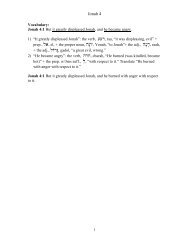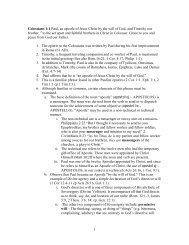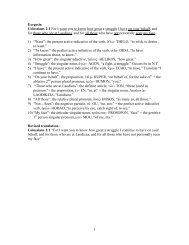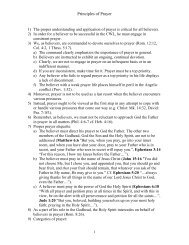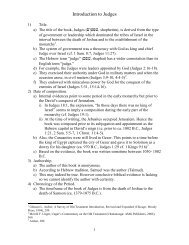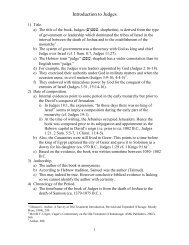doctrine of the hypostatic union and kenosis - Faith Bible Church
doctrine of the hypostatic union and kenosis - Faith Bible Church
doctrine of the hypostatic union and kenosis - Faith Bible Church
Create successful ePaper yourself
Turn your PDF publications into a flip-book with our unique Google optimized e-Paper software.
DOCTRINE OF THE HYPOSTATIC UNION AND<br />
KENOSIS<br />
E. The life <strong>of</strong> Christ subsequent to His birth in Bethlehem reveals <strong>the</strong> same<br />
normal human development <strong>and</strong> growth. Luke 2:52 “And Jesus kept<br />
increasing in wisdom <strong>and</strong> stature, <strong>and</strong> in favor with God <strong>and</strong> men.”<br />
F. In His life, He experienced similar feelings <strong>and</strong> limitations as o<strong>the</strong>r human<br />
beings. His physical movements corresponded to a genuine human nature<br />
<strong>and</strong> human body.<br />
G. He, according to Scriptures, was able to suffer pain, thirst, hunger, fatigue,<br />
pleasure, rest, death, <strong>and</strong> resurrection (John 19:18).<br />
H. Both before <strong>and</strong> after His resurrection, He could be seen <strong>and</strong> felt. His<br />
human body was tangible to human touch (Matt. 26:67, Lk. 24:39,<br />
John.20:24-29).<br />
I. His true humanity is also recognized in scripture by <strong>the</strong> human titles which<br />
were given to Him, such as "Son <strong>of</strong> Man", "<strong>the</strong> Man Christ Jesus", "<strong>the</strong><br />
Son <strong>of</strong> David", etc (Mk 2:10, 10:47).<br />
J. The Scripture also indicates that He possessed a rational human soul<br />
(Matt.26:38, John 12:27).<br />
K. For those who accept <strong>the</strong> <strong>Bible</strong> as authoritative, <strong>the</strong>re can be no question<br />
that Jesus Christ was in all reality true humanity.<br />
IV. Why was it necessary for <strong>the</strong> Lord to become humanity?<br />
A. To be our Savior (Heb 2:15).<br />
B. To be <strong>the</strong> mediator between God <strong>and</strong> men. A mediator must be equal with<br />
both parties (1 Tim 2:5 cp, Job 9:32-33)<br />
C. To be <strong>the</strong> High Priest who can represent believers before God <strong>the</strong> Fa<strong>the</strong>r<br />
(Heb. 7:12-14, 24-28; 10:5-14).<br />
D. To be David’s Greater Son sitting on His throne. In order for <strong>the</strong> promise<br />
to be fulfilled, not only did Jesus Christ have to be true humanity, but He<br />
had to be born into <strong>the</strong> direct line <strong>of</strong> David (2 Sam. 7:8-16, Psa. 89:20-37).<br />
V. The purposes <strong>of</strong> <strong>the</strong> incarnation.<br />
A. To reveal God to <strong>the</strong> human race (John 1:18, 14:7-9).<br />
B. To bypass <strong>the</strong> curse <strong>of</strong> Adam via <strong>the</strong> virgin birth (Lk. 1:35 cp. Rom 5.15).<br />
C. To be <strong>the</strong> sacrifice that made atonement for sin (Eph. 5:2, Heb. 9.26,<br />
10:12).<br />
D. To set an example (1 Peter 2:21, 1 John 2:6 cp. Col 1:10).<br />
E. To destroy <strong>the</strong> works <strong>of</strong> <strong>the</strong> Devil (1 John 3:8).<br />
F. To be a judge (John 5:22-27).<br />
VI. The <strong>union</strong> <strong>of</strong> <strong>the</strong> divine <strong>and</strong> human natures.<br />
A. The evidence from both <strong>the</strong> deity <strong>and</strong> true humanity <strong>of</strong> Christ makes it<br />
evident that <strong>the</strong>se two widely differing sets <strong>of</strong> attributes were brought<br />
toge<strong>the</strong>r into a personal <strong>union</strong>, which will continue forever.<br />
B. Sometimes Christ spoke <strong>and</strong> operated in <strong>the</strong> sphere <strong>of</strong> His humanity <strong>and</strong> in<br />
o<strong>the</strong>r cases, in <strong>the</strong> sphere <strong>of</strong> His deity. However, in all cases, what He did<br />
<strong>and</strong> what He was could be attributed to His one person.<br />
C. Even though it is evident that <strong>the</strong>re were two natures in Christ, He is never<br />
considered a dual personality.<br />
D. The normal singular pronouns such as I, You, <strong>and</strong> He are used <strong>of</strong> Him.<br />
2




